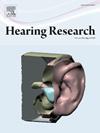伴有和不伴有耳鸣的人中枢听觉神经系统抑制的皮层听觉诱发电位指标的收敛效度。
IF 2.5
2区 医学
Q1 AUDIOLOGY & SPEECH-LANGUAGE PATHOLOGY
引用次数: 0
摘要
耳鸣是在没有外界刺激的情况下对铃声、嗡嗡声或其他声音的感知。减少中枢听觉神经系统抑制是一个普遍报道的机制,有助于一个人的耳鸣感知。不同的皮层听觉诱发电位(CAEP)研究支持耳鸣患者抑制降低的存在。尽管先前用于研究耳鸣的caep确实广泛地代表了抑制功能,但尚不完全清楚不同的caep在个体中是否存在相似的表现。为了解决这一知识空白,目前的研究评估了广泛反映抑制功能的不同caep之间的收敛效度,称为感觉门控和发病补偿caep。根据受试者耳鸣状态、刺激频率和CAEP量化方法,评估感觉门控和发病-偏位CAEP之间的收敛效度。结果表明,指示抑制功能的感觉门控和发病偏移CAEP反应不具有很强的收敛效度。此外,收敛效度的强度在有和没有耳鸣的人之间没有差异。然而,与高频刺激和更孤立的振幅测量(如峰值振幅)相比,产生更稳健caep的实验因素(如宽带刺激)和更全面的振幅测量(如总反应面积)产生了更好的收敛效度。总的来说,这些发现表明,以感觉门控和发病补偿caep为代表的特定抑制机制不同。因此,每个CAEP可能更适合研究不同的种群和/或抑制功能。本文章由计算机程序翻译,如有差异,请以英文原文为准。
Convergent validity of cortical auditory evoked potential indices of central auditory nervous system inhibition in people with and without tinnitus
Tinnitus is the perception of a ringing, buzzing, or other sound without the presence of an external stimulus. Reduced central auditory nervous system inhibition is a commonly reported mechanism contributing to a person's tinnitus perception. Different cortical auditory evoked potential (CAEP) studies have supported the presence of reduced inhibition in people with tinnitus. Although previous CAEPs used to study tinnitus do broadly represent inhibitory function, it is not entirely clear if the different CAEPs present similarly within an individual. To address this gap in knowledge, the current study evaluated the convergent validity between different CAEPs that broadly reflect inhibitory function, called sensory gating and onset-offset CAEPs. Convergent validity between sensory gating and onset-offset CAEPs was evaluated as a function of participant tinnitus status, stimulus frequency, and CAEP quantification approach. The results indicated that sensory gating and onset-offset CAEP responses indicative of inhibitory function did not demonstrate strong convergent validity. Further, the strength of convergent validity did not differ between people with and without tinnitus. However, experimental factors that yielded more robust CAEPs, such as broadband stimuli, and more comprehensive measures of amplitude, such as total response area, resulted in better convergent validity compared to higher frequency stimuli and more isolated measures of amplitude like peak amplitude. Overall, these findings suggest that the specific inhibitory mechanisms represented by sensory gating and onset-offset CAEPs differ. Therefore, each CAEP may be better suited to study distinct populations and/or inhibitory functions.
求助全文
通过发布文献求助,成功后即可免费获取论文全文。
去求助
来源期刊

Hearing Research
医学-耳鼻喉科学
CiteScore
5.30
自引率
14.30%
发文量
163
审稿时长
75 days
期刊介绍:
The aim of the journal is to provide a forum for papers concerned with basic peripheral and central auditory mechanisms. Emphasis is on experimental and clinical studies, but theoretical and methodological papers will also be considered. The journal publishes original research papers, review and mini- review articles, rapid communications, method/protocol and perspective articles.
Papers submitted should deal with auditory anatomy, physiology, psychophysics, imaging, modeling and behavioural studies in animals and humans, as well as hearing aids and cochlear implants. Papers dealing with the vestibular system are also considered for publication. Papers on comparative aspects of hearing and on effects of drugs and environmental contaminants on hearing function will also be considered. Clinical papers will be accepted when they contribute to the understanding of normal and pathological hearing functions.
 求助内容:
求助内容: 应助结果提醒方式:
应助结果提醒方式:


